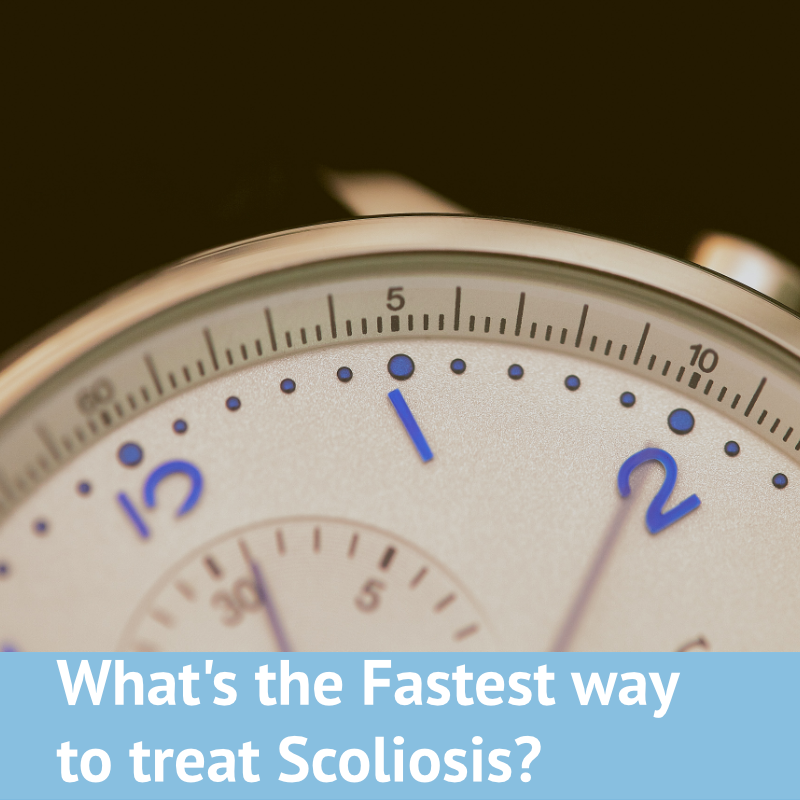
When you or a family member is diagnosed with Scoliosis, it’s only natural to want to know what the fastest way to treat the condition is. At the UK Scoliosis Clinic, we always stress the need to get a quick diagnosis, as Scoliosis can progress quickly – so acting early makes treatment much easier. But once Scoliosis is diagnosed, how long does treatment take and what’s the fastest option?
What do we mean by treatment anyway?
Before we explore the fastest possible option for treating Scoliosis, it’s important that we first understand what “treatment” means here. There are two main aspects which Scoliosis treatment is broken down into – firstly, there’s the Cobb angle, this is how much the spine is “curved” away from the position in which it should ideally sit. Secondly, there are the associated factors which arise from scoliosis or are exacerbated by it. These include physical factors such as muscle weakness, as well as psychological factors associated with deformity, anxiety etc.
Treating the Curve
Research shows clearly that Scoliosis bracing is the fastest possible way to reduce cobb angle – longer daily bracing periods will reduce curves faster than shorter periods, with patient adherence to wear-time being the main aspect for success. Choice of brace is also of critical importance here – an active brace, like ScoliBrace, must be used, since a passive brace is not designed to correct the Cobb angle, only to hold it in place.
The best possible option in terms of speed is, therefore, full time bracing with an active brace, such as ScoliBrace. A recent study which compared the two main treatment pathways, scoliosis bracing and scoliosis exercise showed that bracing yielded an average reduction in Cobb angle at 6 months of 3.13 degrees, and at 12 months of 5.88 degrees. This compared favourably with another trial group using an exercise-based approach – here, the 6 months mean reduction was just 0.66 degrees, and at 12 months was 2.24 degrees.[1]
This figure is somewhat misleading, however, since it also factors for subjects who did not wear their brace as instructed or for the time required – nor was the brace use in the study the ground-breaking new ScoliBrace which we offer. While our results depend to a large degree on the individual case, below are some case studies using the ScoliBrace – all of which achieved better than 25-degree curve correction in roughly 2 years.
Treating associated factors
While scoliosis bracing is clearly the fastest way to reduce cobb angle, it’s also important to strengthen the muscles around the spine, and improve the posture overall to equip the patient for life after Scoliosis. Indeed, treating the cobb angle alone may even lead to increased muscle weakness in the future, due to the supportive work being taken up by the brace, rather than the appropriate muscles.
Scoliosis specific exercise is a highly effective approach for heading off these issues – having been shown to be effective in improving overall quality of life scores, as defined by the SRS 22 questionnaire, a standard tool used to gauge the impact scoliosis has on a persons life. In the study mentioned above, the group treated with scoliosis specific exercise showed improvements in all the SRS-22 quality of life scores, and a significant improvement in terms of the functional score, a measure of physical impact on daily life from scoliosis. [2]
While any form of exercise (and the sense of control and ownership it can bring) will have a positive psychological effect, the same study also noted a significant improvement in self-image amongst the bracing group – especially after the 12 months follow up. Simply put, the reduction in deformity seemed to translate to a tangible improvement in self-image – which, coupled with exercise, can go a long way to beating the psychological issues caused by Scoliosis. [3]
The fastest way to treat Scoliosis
Put simply, the fastest way to treat scoliosis is Active bracing – with a brace like ScoliBrace. Scoliosis specific exercise will reduce scoliosis over time, but only at a much slower rate. This makes it applicable for small curves where a large correction is not required, however, if the goal is to correct a small curve quickly, bracing is still a better choice. This being said, it’s only half the story – beating scoliosis means leaving a patient with a reduced, or eliminated Cobb angle and ensuring that they are physically fit, functionally capable and psychologically ready to move on and leave Scoliosis behind.
It’s for this reason that the UK Scoliosis clinic prefers a multifaceted approach to Scoliosis, making use of bracing, exercise and complementary approaches to provide a treatment plan which aims to address all aspects of scoliosis – in the short, and the long term.
[1] Yu Zheng, MD PhD et al. Whether orthotic management and exercise are equally effective to the patients with adolescent
idiopathic scoliosis in Mainland China? – A randomized controlled trial study SPINE: An International Journal for the study of the spine [Publish Ahead of Print]
[2] Yu Zheng, MD PhD et al. Whether orthotic management and exercise are equally effective to the patients with adolescent
idiopathic scoliosis in Mainland China? – A randomized controlled trial study SPINE: An International Journal for the study of the spine [Publish Ahead of Print]
[3] Yu Zheng, MD PhD et al. Whether orthotic management and exercise are equally effective to the patients with adolescent
idiopathic scoliosis in Mainland China? – A randomized controlled trial study SPINE: An International Journal for the study of the spine [Publish Ahead of Print]


